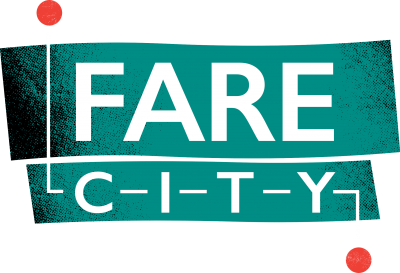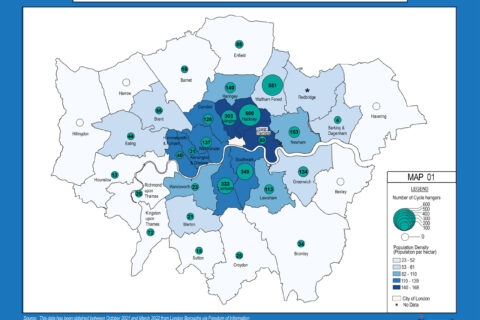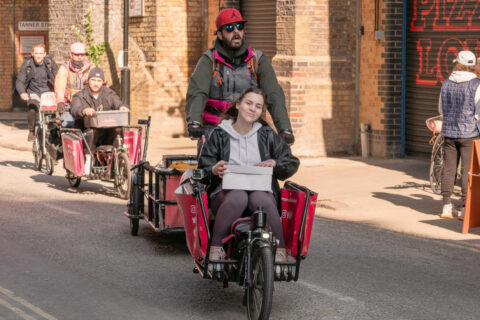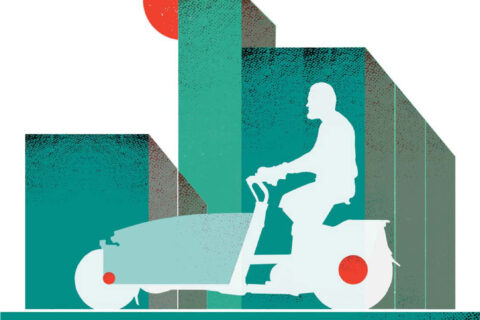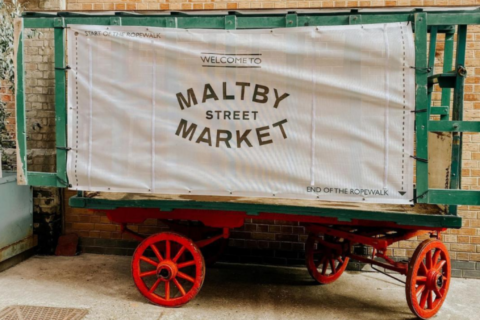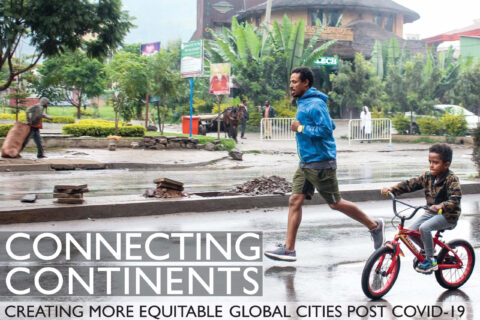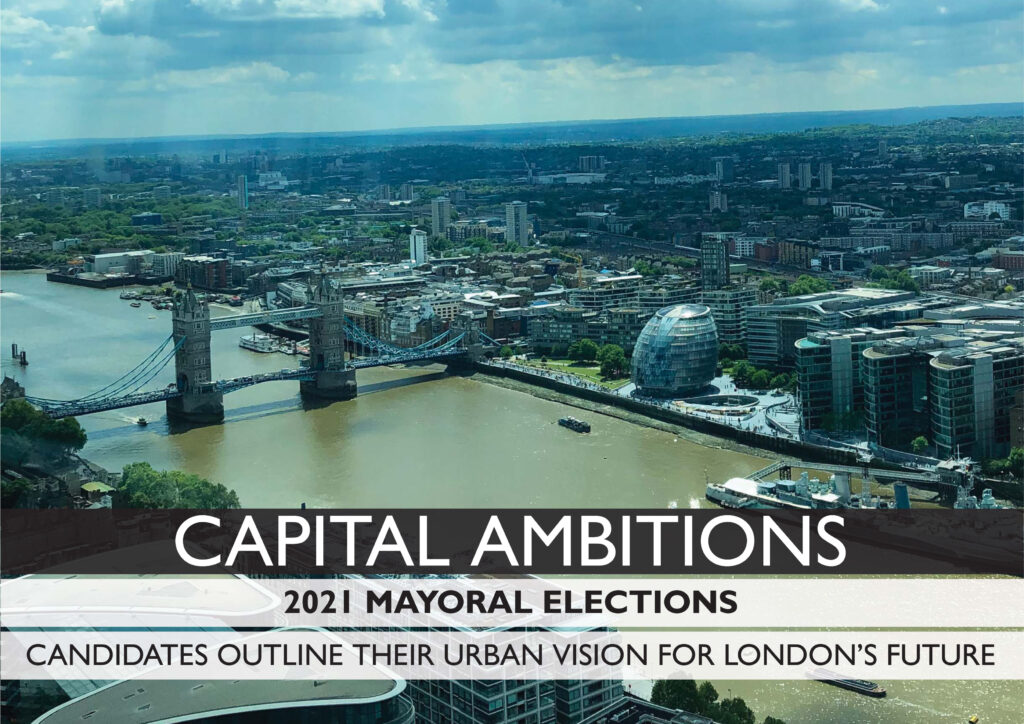
By Fare City
In the run up to the 2021 London mayoral elections, Fare City and Pedal Me have interviewed three of the four main party candidates on the transport, urban and environmental issues which matter to Londoners. The interviews were conducted in the front of a cargo bike to highlight the need for candidates to consider the role that more sustainable modes of transport may play in the future of the city.
The interviews provided the candidates with the chance to share their vision for London, while enabling Londoners to better understand the candidates’ plans to address the specific challenges and opportunities facing the capital, if elected. The research analyses these interviews and makes recommendations to the next mayor, to promote a more accessible, equitable and sustainable city for all Londoners in the decade ahead.
You can read the project brief and full interview transcripts here.
Sian Berry arrives punctually at our meeting point on an overcast morning at London’s Southbank. She is the first of three London mayoral candidates to join us for our cargo bike interviews. We had initially interviewed the Green Party Co-Leader in March 2020, just before the first nationwide lockdown. Back then, despite the fine weather, this same spot was eerily deserted as the seriousness of the COVID-19 pandemic began to take hold across the UK.
Like last year, Berry takes a closer look at the cargo bike which will soon be transporting her the three miles to City Hall via Cycle Superhighway 3. City Hall is a building she is familiar with from her current role as a London Assembly Member, but one she soon hopes to work out of as the capital’s next mayor.
In subsequent weeks we will be joined by two more candidates, the Liberal Democrats’ Luisa Porritt, and the Conservatives’ Shaun Bailey. The latter is the candidate widely considered to be the biggest threat to the incumbent Labour Mayor of London, Sadiq Khan. In our interviews, each candidate is keen to outline why their vision for London is the right one, and how they intend to provide assured leadership for Londoners as the capital begins to emerge from a year of debilitating restrictions.
London’s mayoralty is now twenty-one years old. However, many Londoners are still unsure as to the role and remit of the mayor and the true extent of their power. Despite this, the Mayor of London commands the largest personal mandate for any politician in the country, and as the chair of TfL is responsible for the city’s transport network.
The role of transport in shaping a global city fit for the unique circumstances of the 2020s extends beyond streets, space and infrastructural systems; it informs the development of neighbourhoods and communities, promotes better health, wellbeing, and environment, and, above all, has the potential to foster greater equity and a better quality of life for all Londoners. We analyse these interdependent themes, along with governance – namely the powers of the mayor – to explore what the future of London could look like.
“I’ve set a target for zero deaths on the road… that’s a duty you have as Mayor to keep people safe…”
Streets, Space and Systems
Managing the capital’s transport infrastructure
Both Sian Berry and Luisa Porritt consider that the reduced use of London’s streets, tube and bus networks are among the biggest transport changes in London this past year. The circumstances of the pandemic have led to prolonged lockdowns and changing work and leisure patterns, all of which have contributed to a decline in public transport use. Additionally, the need to socially distance has necessitated the creation of more space for those continuing to complete their journeys on the city’s streets and public transport.
Unlike other global cities, London was initially slow to create space for those walking and cycling. However, the mayor and TfL soon implemented an ambitious Streetspace Plan which saw measures – including footway widening, emergency cycleways and partial street closures – rapidly introduced throughout the capital.
All three candidates agree that the Streetspace Plan is the right programme for London. Berry acknowledges that the progress over the last year by the Conservative government and Labour mayor is “quite good”, but counters that it should have been introduced “years ago,” which would have enabled it to be implemented “more carefully and [would have] brought more people with us”.

Porritt, too, believes that “it’s really important to bring local communities along” and cites the lack of consultation as being problematic, whereas Shaun Bailey states that “you keep the Streetspace Plan, but you do modify it”. The lack of Streetspace consultation has led to the mayor and TfL losing a High Court ruling in January 2021, which concluded that some measures were illegal and subsequently threw the future of many other schemes into jeopardy.
The most controversial urban measures are Low Traffic Neighbourhoods, or LTN’s. LTN’s are implemented by London boroughs and are currently partially funded through the Streetspace Plan. Bailey has been one of the most vocal critics of the schemes and has publicly pledged to “hold consultations within 100 days and scrap every LTN that a majority of residents don’t want”.
In our interview, he states that “in many schemes [LTNs] have led to far reduced air quality as there’s much more traffic on the local road”, and that the mayor and TfL are guilty of “very little assessment and even less consultation”. Ultimately, however, he sees poor planning as “the villain”, not LTNs, concluding that “as mayor I will do much more around the planning of delivering LTNs”.
By contrast, Sian Berry states that “we absolutely need more of them… the benefits are clear, the evidence is in”. Berry views LTNs as part of a “comprehensive rethinking of how we use our streets” and references the 2016 Waltham Forest ‘Mini Hollands’ scheme as proof of where they have been successfully implemented. Arguably, London’s failure to build on the success of the ‘Mini Hollands’ pilot has meant that similar recent schemes, rapidly introduced with little consultation, have been divisive.
This is just one example of how London has suffered from the lack of a clear urban vision. Global cities such as Bogota, Auckland and, most recently, Paris were able to implement further, as opposed to forced experimentation when the pandemic hit – a result of having a clear urban strategy whereby measures were implemented more incrementally.
Neighbourhoods and Community
Rethinking planning and place
Changing work and leisure patterns have left many Central London office spaces redundant, as greater levels of homeworking look set to stay. Luisa Porritt sees this as a “once in a generational opportunity to finally fix the affordability crisis” and has pledged to implement her flagship housing policy ‘Homes in the Heart of the City’, if elected. While a Central London address is highly prized, though still unobtainable for most Londoners, to what extent has the pandemic shifted Londoners’ perceptions of what makes a good home?
For many of those residing in Central London, the spring 2020 lockdown meant limited access to green space, few amenities and social isolation. This is perhaps reflected by the fact that after years of exponential growth, London’s population is set to contract for the first time in over 30 years. Though outward migration from big cities appears to constitute a short-term trend, it must challenge the idea of place, the function of a city centre and the role of the mayor in shaping a more equitable vision for Central London moving forward.
While Central London is slowly reopening, many outer London neighbourhoods have thrived in the last year, as people stayed close to home and supported local businesses and communities. The fostering of ‘community capital’ is something Porritt is keen to promote, citing the implementation of the 15-minute city in Paris, where all amenities are located within a 15-minute walk or cycle ride away. Porritt envisages a move away from the “old fashioned retail-led model of high streets” and a “shift towards a more services-based model”, with more co-working spaces for those unable to work from home.
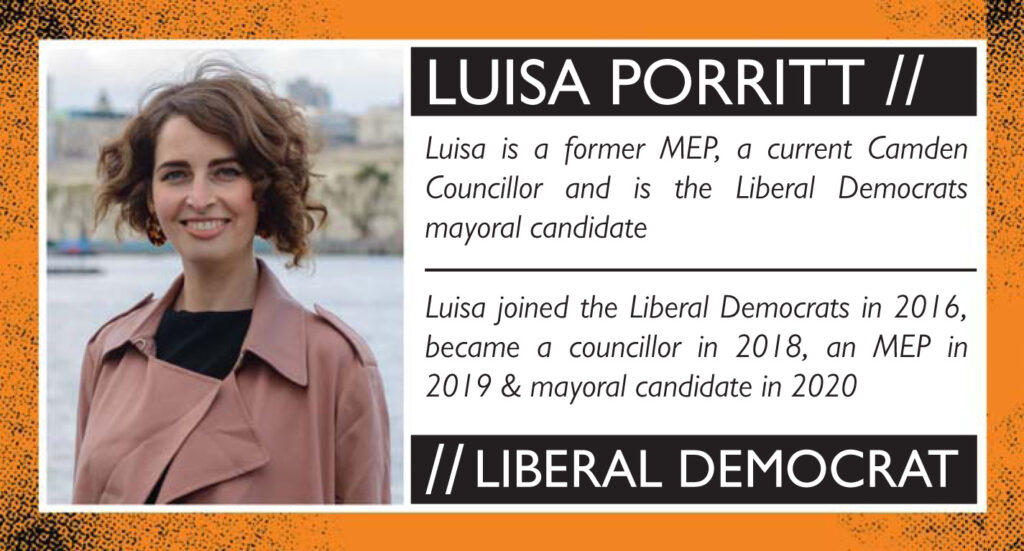
By contrast, Shaun Bailey’s vision for outer London is based around the revival, rather than the reimagination, of the high street. If elected, he has pledged to provide 30-minute free parking for high streets in outer London boroughs. This is to help residents support local businesses, something he sees as vital to get London’s economy moving again. Bailey has additionally pledged to scrap any proposed boundary charge for Londoners driving into Central London, a proposed policy at odds with Sian Berry’s own ‘Flat Fares’ initiative.
Berry first pledged Flat Fares in 2016, a system whereby those using public transport would pay the same to travel to and from outer London as they do to travel around Central London: “one zone, one fare, like we have on the buses – it’s not rocket science”. While both Bailey’s and Berry’s plans are designed to help outer Londoners, from “police officers to plumbers” and “those working in the pubs, in the shops in the cafés of Central London” respectively, it does raise questions about the mayor’s role in rethinking the dynamic between central and outer London. Could different parts of the city fulfil new and diverse needs? And should London rush to return to business as normal?
“The 15-minute city… that’s at the heart of my vision for London”
“Absolutely, reducing car dependency features in my plans”
Health, Wellbeing and the Environment
Delivering better health outcomes for all Londoners
Air quality is a key issue traditionally associated with Central London, but one that has most recently been considered in the context of the capital’s outlying boroughs. Road vehicles are the single biggest cause of the capital’s air pollution and are responsible for around half of all nitrogen dioxide (NO2) pollution, in addition to being a major contributor of particulate matter (PM2.5). In 2003, London’s first mayor, Ken Livingstone, introduced the congestion charge zone, an initiative which was followed nearly two decades later by the incumbent mayor’s progressive Ultra Low Emission Zone (ULEZ) in 2019.
Despite these bold initiatives, recent research has shown that those living, working and studying in proximity to the city’s ‘red routes’ – the TfL-controlled strategic road network – are still subject to dangerous levels of air pollution. The mayor plans to extend the current ULEZ to the North and South Circulars in October 2021, and while candidates Sian Berry and Luisa Porritt agree with the extension, both contend that only a smarter road pricing scheme will work to tackle pollution from the city’s road transport.
The origins of a city-wide smarter road pricing scheme can be traced to the work of Green Party assembly members, who a decade ago commissioned a study into London’s traffic. The report suggested a 10 per cent reduction could be achieved via a road pricing scheme, an idea that was put forward for further consultation in Berry’s own 2016 mayoral manifesto. In 2017, Green Party and Liberal Democrat assembly members proposed a budget amendment for a study to investigate the feasibility of a road charging system, a comprehensive report on this issue was completed in 2019.
Berry considers a road pricing scheme to be the “comprehensive, transformative policy that we need” and one that gives TfL the ability to “pull smart levers, like incentivising driving outside of busy times”. Porritt, too, believes in the value of a “fairer pay as you go” road pricing scheme, but reflects that it would not only represent an environmental but also an economic boon for TfL, by putting the authority on a more “sustainable financial footing”.
Implementation of such schemes will, however, take time. Research into a London scheme is envisaged to take five years from conception to becoming fully operational. This would suggest that the ULEZ extension represents the best short-term solution for addressing the capital’s air quality.
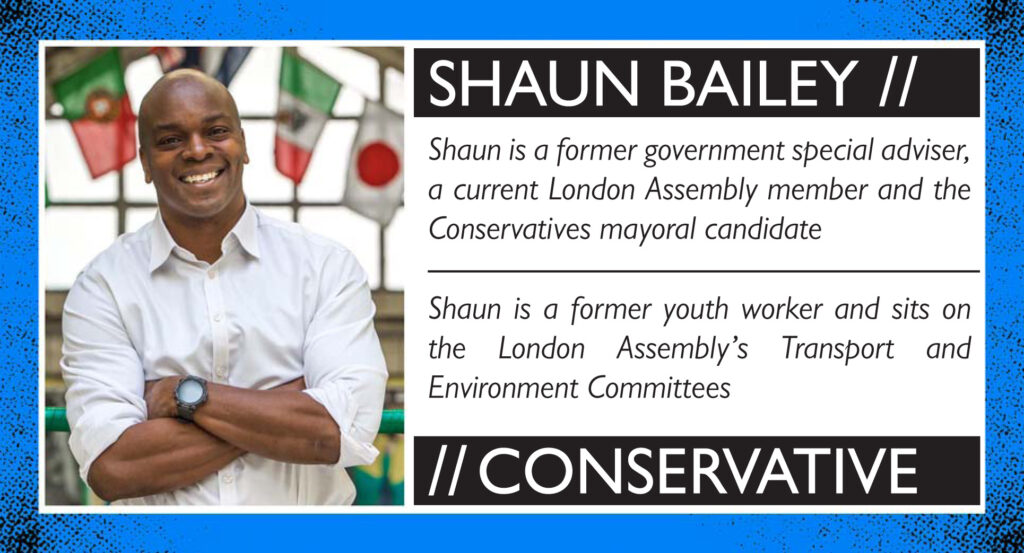
A 2021 London Assembly Environment Committee report concluded that the ULEZ is the ‘biggest single contributor to a reduction in NO2 concentrations’ in London. However, one of the committee’s members, Shaun Bailey, has pledged that if elected he would not extend the ULEZ. Bailey believes that the ULEZ extension will become a “perverse incentive” that will encourage people to pollute as they will “just pay the tax and we’ll continue to get the pollution”.
Instead, Bailey pledges to make the entire London bus fleet zero emission by 2025, which he states is “the equivalent to taking 1.1 million cars off the road”. Additionally, he states that switching all black cabs to zero emission “is again, the equivalent of taking another million cars off the road”. More fundamentally, Bailey sees the congestion charge, the ULEZ and other levies imposed on motorists as disproportionately impacting poorer Londoners, many of whom only drive “because there is no alternative”.
Bailey cites car clubs as evidence that reducing car dependency does feature in his plans, though health inequalities compounded by private car use extends beyond tailpipe emissions. Cars generate brake dust, tyre particulates and require more road space. Their ability to travel at higher speeds than other modes of transport presents a greater danger to vulnerable road users, while their widespread use contributes to physical inactivity. A controversial road-building scheme that encompasses these issues, and others, is the Silvertown Tunnel, a £2 billion river crossing located in the east of the city.
The incumbent mayor signed the contract for the scheme in 2019, stating that it would serve to reduce traffic congestion. Bailey agrees with Khan on this issue, stating that the tunnel needs to be viewed “in the context of the whole of London” as it would have a benefit for the movement of traffic and would even “alleviate a massive air quality problem”.
Luisa Porritt pledges to scrap the tunnel if elected, raising the idea of ‘induced demand’ whereby if supply increases so too will demand, thereby mitigating any perceived benefits. Berry, too, would cancel the project if elected, but reasons that if that were not possible, reappropriating the tunnel for public transport, walking and cycling would be her preference.
“This is an opportunity to reset relationships between the mayor and the Government”
Governance
Powers of the mayor
While all three candidates are confident about the changes they would implement if elected mayor, the process of turning their pledges into policy is less assured. Though the Mayor of London does have a certain set of powers at their disposal, the office is generally considered to wield less authority than those of other global cities, such as Bogota in Colombia.
As the chair of TfL, some of the key areas the mayor is responsible for include public transport, the city’s strategic road network, and the transport budget. However, unlike most other global cities, TfL does not receive a direct government grant to cover ongoing costs. Pre-pandemic the authority was dependent on fares for 80 per cent of its revenue generation, a significant source of income that was hit hard owing to lower ridership because of COVID-19.
Additionally, the overlapping patchwork of the city’s governance necessitates that the mayor must navigate a course through both the lower and higher tiers of policymakers who have a say in how the city is run. The former includes London boroughs and the London Assembly, while the latter comprises MP constituencies and central government.
Both Shaun Bailey and Sian Berry are serving London Assembly Members. The assembly comprises an elected twenty-five-person council with limited powers to scrutinise the mayors’ actions. Experience of working on committees and questioning the mayor periodically, arguably provides both candidates with an advantage over others in understanding what the powers of the mayor’s office encompass.
Bailey’s pledge to “hold consultations” to scrap unwanted Low Traffic Neighbourhoods would likely be within his powers if elected mayor. However, any claims that the mayor’s office could directly remove LTNs is unfounded as the schemes are located on borough-controlled roads. Similarly, the Royal Borough of Kensington and Chelsea were able to autonomously remove the Kensington High Street cycle lane in the west of the city, as it was located on a borough-controlled road.
When questioned on whether the mayor should have the authority to overrule the local council on this issue, Berry confirmed that the mayor does have the powers to apply to the Secretary of State for Transport to bring the road onto TfL’s strategic network. This is something that the incumbent mayor, Sadiq Khan, has previously suggested he would do.
Luisa Porritt has pledged that she would ‘demand special powers’ from central government to enable her to deliver her ‘Homes in the Heart of the City’ programme if elected. She reasons that this would “require some negotiation with the government” but would be “an opportunity to reset relations”. Though there is no legal impediment to achieving this, Khan’s year-long delay in delivering the ‘London Plan’ – owing to changes imposed by the housing secretary – suggests that expediting the rollout of mayoral programmes may prove challenging.
The Conservative candidate, Bailey, would appear to hold a party advantage in this respect. If elected, he would create an ‘infrastructure bank’, something he sees as essential in not only delivering projects for Londoners, such as Hammersmith Bridge, but a programme that would “rebuild the trust between London and government”. By raising funds using mayoral levies and business rates, prior to then “leveraging it in the markets”, Bailey states that this would incentivise the government to “meet him halfway”. However, it does appear that some of his transport policies are at odds with those of central government. These are policies that would have to be reconciled one way or the other if elected.

Equity and Quality of Life
Creating a fairer London
All candidates acknowledged that the mayor has both the ability, and the responsibility, to offer a strategic vision for improving the quality of life for all Londoners. The role of transport is fundamental in facilitating this, as it enables physical, economic, and social mobility. Transport has, however, traditionally been biased in favour of men over the needs of others. This raises questions about what candidates would do to promote a more inclusive, and safer, transport network that caters for groups that are currently marginalised.
Luisa Porritt believes that the issue runs deeper than infrastructural improvements. She cites the need for a “culture change to root out misogyny”, but does consider that providing incentives that encourage people to alter their behaviour is critical in leading to longer-term lifestyle changes. Her ‘Cycle Sundays’ pledge would provide people with the opportunity to hire the city’s Santander cycles free of charge every Sunday, an initiative which she hopes will lead to more Londoners buying a cycle.
Sian Berry asserts that more could be done to implement practical measures on London’s public transport network, including providing additional space on buses for both buggy and wheelchair users. Berry additionally praised the continued implementation of segregated cycle lanes, which enable “children to cycle… older people… people who are disabled to use specially adapted bikes”. By contrast, Shaun Bailey considers that “one of the failings of the segregated cycle scheme is that it doesn’t introduce new cyclists”. He believes that ‘Quietways’ are the way that “most young people… women and people from ethnic minorities, such as me, would learn to cycle”.
While many younger Londoners, are benefitting from new mobility options such as e-scooters, the vast majority are still reliant on more traditional modes. One of the stipulations of a future TfL bailout by central government is that concessionary public transport, for both under-18’s and over 60’s, may have to be cut. All candidates recognised the importance of concessionary fares and have pledged to protect them, but differ in their approach for funding this.
Sian Berry states that she would lobby the government to reinstate TfL’s operating grant. She says that she would make this a top priority, and though she acknowledges it is “quite a bit of money” she does not consider it to be “out of the bounds of affordability”. By contrast, both Luisa Porritt and Shaun Bailey would raise revenue via a road user charging scheme and commercial sponsorship of the tube, respectively. Porritt believes that her scheme would not only meet the “existing costs that TfL has, but potentially raise additional revenue”.
Bailey is keen to enlist big business to invest in the capital’s tube network. He is confident that his scheme, similar to one in Dubai, would generate “a conservative target of £500 million”. He states that any surplus could be “put to other good things” including initiatives for better disabled access and improving workplace conditions for disabled staff.
The relationship between big business and the provision of better workplace conditions, specifically for gig economy workers utilising city transport networks, is a pertinent issue. Its impact is widely felt, as it not only affects the quality of life for workers, but it also financially disadvantages firms that hire staff as employees – because of tax payments which gig economy competitors can avoid. In February 2021, London’s UBER drivers won a Supreme Court case for better employment rights against the ride-hailing provider, something all three candidates supported.
While all three candidates recognise that the mayor has the power to license private hire vehicles in London, they cannot refuse a licence if the applicant meets the regulations set by central government. Porritt reasons that “this goes beyond the powers of the mayor”, whereas Bailey considers it a long-term issue which requires the mayor to “take the government on”. Berry, too, states that the mayor “can campaign for things to be done at a national level”. If little else, the need to work constructively with government to ensure a better quality of life for all Londoners is something all three candidates are in agreement with.
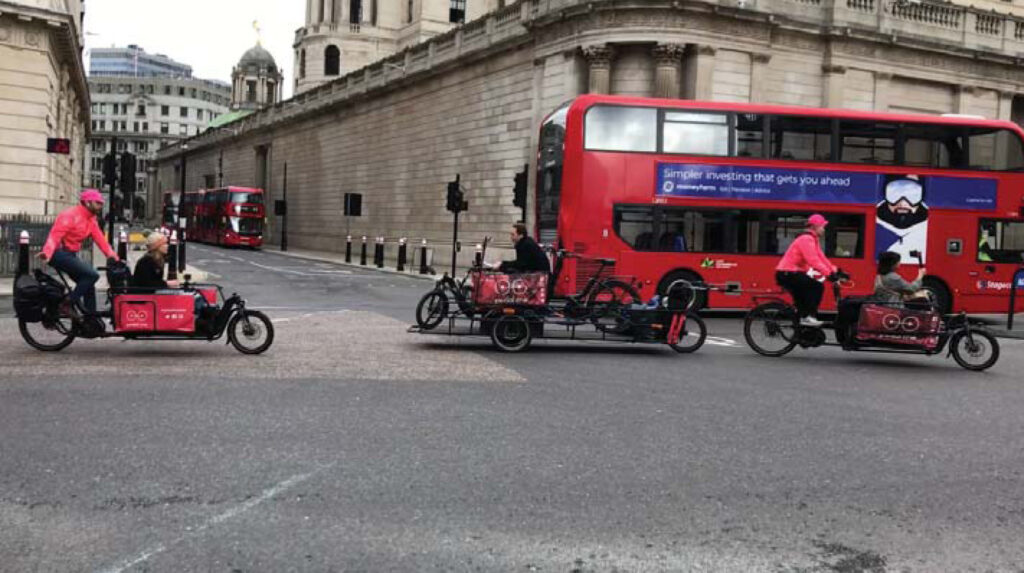
“We have to stop charging people in outer London more for their travel just because of where they live”
“If you’re a young person get a pedal bike because cycling is the way forward, great fun, great speed”
Fare City Recommendations
Actions for London’s next mayor
London’s next mayor must guide the capital through its post-pandemic recovery to ensure that the city both retains and builds upon, hard won transport, urban and environmental gains. These gains include the reallocation of city space for users using non-motorised modes, the renewal of localism and an increased awareness of the need to find equitable solutions to address pressing economic and environmental issues. London’s next mayor will be restricted to a three-year term, meaning that they will need to move quickly yet skilfully, if they are to leverage the powers of the office to simultaneously accelerate the rollout of existing initiatives – while successfully implementing new ones.
The pace of change necessitated by the pandemic means that the upcoming mayoral term, though short, will be critical in securing the city’s trajectory in the decade ahead. The need for London’s next mayor to serve as a proactive and responsible custodian for the future of the city has never been more acute; clean air, climate resilience, more prosperous communities and a safer, more equitable, transport network are prerequisites for a successful London moving forward. Our recommendations state how the capital’s next mayor can build upon these gains to secure the best possible future for all Londoners in the months and years ahead.
Implement a road user charging scheme:
London’s next mayor should introduce a comprehensive road user charging system as a priority. While the ULEZ expansion represents the best short-term measure for reducing the damaging impacts of motor vehicle traffic, only a smart scheme which charges users based on multiple metrics represents a viable longer-term measure. A range of interdependent issues – from improving air quality and encouraging sustainable mobility options, to aiding TfL’s finances – would benefit from such a scheme. The mayor must introduce road user charging in earnest, especially given that central government is looking into the feasibility of a nationwide scheme. This could ensure that revenue from any levies accrued in the capital directly benefit Londoners.
Develop a city-wide vision for London’s neighbourhoods:
London’s next mayor should focus on creating a targeted package of measures which respond to the evolving needs of different types of city neighbourhood, be they in central, inner or outer London. This should simultaneously build upon – and bring together – the progress made by existing programmes including ‘Future Neighbourhoods 2030’, ‘High Streets for All’, ‘Streetspace’ and the ‘Green New Deal’. These measures must consider both the current needs and future aspirations of communities in these neighbourhoods, to ensure that the correct balance between revival and reimagination is struck. Doing so will work to secure each neighbourhood’s own unique version of what it means to be a people and place focused entity, which functions successfully within the urban context of the city as a whole.
Establish an inclusive transport working group:
London’s next mayor should establish an inclusive transport working group. Such a group would bring together emerging organisations championing the rights of marginalised Londoners across the capital’s transport, urban and environmental sectors. Though TfL and the GLA currently run initiatives such as ‘Action on Equality’ and the ‘Mayors Equality, Diversity and Inclusion strategy’ respectively, the pandemic has prompted a groundswell of new and diverse organisations. These organisations convey the lived experience of many Londoners through the lens of gender, ethnicity, class and disability and should be supported via a mayoral-led working group. The group should work to collate and coordinate accumulated knowledge on these issues for the consideration of both the mayor and London’s boroughs, while being further disseminated via a city-wide media campaign.

Fare City would like to thank candidates and their teams for agreeing to take part in this study. Full videos of the interviews can be found here. We would additionally like to thank Chris, Ben and the Pedal Me team for their contribution, along with videographer, Philip Schnell.
Article designed by David Maguire
